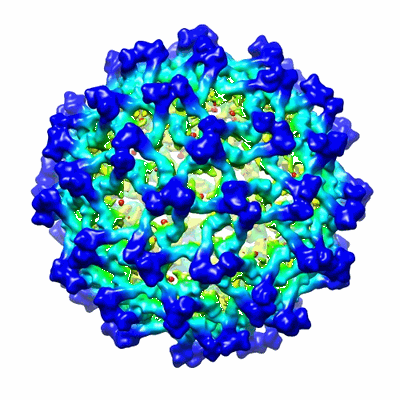EMD-20439
Cryo-EM reconstruction of the immature chimeric BinJV/ZIKV-prME virion
EMD-20439
Single-particle12.2 Å
 Deposition: 07/07/2019
Deposition: 07/07/2019Map released: 08/01/2020
Last modified: 08/01/2020
A recombinant platform for flavivirus vaccines and diagnostics using chimeras of a new insect-specific virus.
Hobson-Peters J  ,
Harrison JJ
,
Harrison JJ  ,
Watterson D
,
Watterson D  ,
Hazlewood JE
,
Hazlewood JE  ,
Vet LJ
,
Vet LJ  ,
Newton ND
,
Newton ND  ,
Warrilow D
,
Warrilow D  ,
Colmant AMG
,
Colmant AMG  ,
Taylor C,
Huang B
,
Taylor C,
Huang B  ,
Piyasena TBH
,
Piyasena TBH  ,
Chow WK
,
Chow WK  ,
Setoh YX
,
Setoh YX  ,
Tang B
,
Tang B  ,
Nakayama E
,
Nakayama E  ,
Yan K
,
Yan K  ,
Amarilla AA
,
Amarilla AA  ,
Wheatley S,
Moore PR,
Finger M
,
Wheatley S,
Moore PR,
Finger M  ,
Kurucz N,
Modhiran N
,
Kurucz N,
Modhiran N  ,
Young PR
,
Young PR  ,
Khromykh AA
,
Khromykh AA  ,
Bielefeldt-Ohmann H,
Suhrbier A
,
Bielefeldt-Ohmann H,
Suhrbier A  ,
Hall RA
,
Hall RA 
(2019) Sci Transl Med , 11
 ,
Harrison JJ
,
Harrison JJ  ,
Watterson D
,
Watterson D  ,
Hazlewood JE
,
Hazlewood JE  ,
Vet LJ
,
Vet LJ  ,
Newton ND
,
Newton ND  ,
Warrilow D
,
Warrilow D  ,
Colmant AMG
,
Colmant AMG  ,
Taylor C,
Huang B
,
Taylor C,
Huang B  ,
Piyasena TBH
,
Piyasena TBH  ,
Chow WK
,
Chow WK  ,
Setoh YX
,
Setoh YX  ,
Tang B
,
Tang B  ,
Nakayama E
,
Nakayama E  ,
Yan K
,
Yan K  ,
Amarilla AA
,
Amarilla AA  ,
Wheatley S,
Moore PR,
Finger M
,
Wheatley S,
Moore PR,
Finger M  ,
Kurucz N,
Modhiran N
,
Kurucz N,
Modhiran N  ,
Young PR
,
Young PR  ,
Khromykh AA
,
Khromykh AA  ,
Bielefeldt-Ohmann H,
Suhrbier A
,
Bielefeldt-Ohmann H,
Suhrbier A  ,
Hall RA
,
Hall RA 
(2019) Sci Transl Med , 11
Abstract:
Flaviviruses such as dengue, yellow fever, Zika, West Nile, and Japanese encephalitis virus present substantial global health burdens. New vaccines are being sought to address safety and manufacturing issues associated with current live attenuated vaccines. Here, we describe a new insect-specific flavivirus, Binjari virus, which was found to be remarkably tolerant for exchange of its structural protein genes (prME) with those of the aforementioned pathogenic vertebrate-infecting flaviviruses (VIFs). Chimeric BinJ/VIF-prME viruses remained replication defective in vertebrate cells but replicated with high efficiency in mosquito cells. Cryo-electron microscopy and monoclonal antibody binding studies illustrated that the chimeric BinJ/VIF-prME virus particles were structurally and immunologically similar to their parental VIFs. Pilot manufacturing in C6/36 cells suggests that high yields can be reached up to 109.5 cell culture infectious dose/ml or ≈7 mg/liter. BinJ/VIF-prME viruses showed utility in diagnostic (microsphere immunoassays and ELISAs using panels of human and equine sera) and vaccine applications (illustrating protection against Zika virus challenge in murine IFNAR-/- mouse models). BinJ/VIF-prME viruses thus represent a versatile, noninfectious (for vertebrate cells), high-yield technology for generating chimeric flavivirus particles with low biocontainment requirements.
Flaviviruses such as dengue, yellow fever, Zika, West Nile, and Japanese encephalitis virus present substantial global health burdens. New vaccines are being sought to address safety and manufacturing issues associated with current live attenuated vaccines. Here, we describe a new insect-specific flavivirus, Binjari virus, which was found to be remarkably tolerant for exchange of its structural protein genes (prME) with those of the aforementioned pathogenic vertebrate-infecting flaviviruses (VIFs). Chimeric BinJ/VIF-prME viruses remained replication defective in vertebrate cells but replicated with high efficiency in mosquito cells. Cryo-electron microscopy and monoclonal antibody binding studies illustrated that the chimeric BinJ/VIF-prME virus particles were structurally and immunologically similar to their parental VIFs. Pilot manufacturing in C6/36 cells suggests that high yields can be reached up to 109.5 cell culture infectious dose/ml or ≈7 mg/liter. BinJ/VIF-prME viruses showed utility in diagnostic (microsphere immunoassays and ELISAs using panels of human and equine sera) and vaccine applications (illustrating protection against Zika virus challenge in murine IFNAR-/- mouse models). BinJ/VIF-prME viruses thus represent a versatile, noninfectious (for vertebrate cells), high-yield technology for generating chimeric flavivirus particles with low biocontainment requirements.
